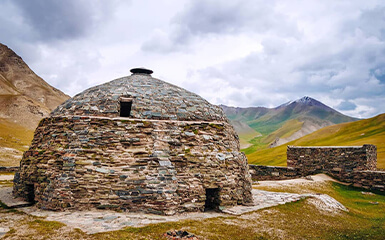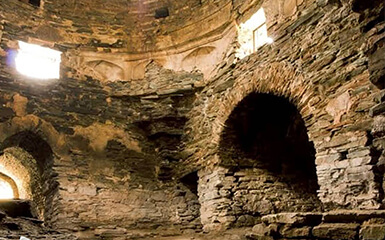Tash Rabat Caravanserai

Tash Rabat is a well-preserved former caravanserai from the 15th century in the Atbashy district in the Naryn region in the Republic of Kyrgyzstan in Central Asia. The name means "stone inn".
Tash Rabat is located in the southern part of the Atbashy mountain range (part of the Tian Shan), the "Heavenly Mountains", at about 3105 m altitude, which follows the course of a branch of the Silk Road from the regional capital of Naryn, about 80 km away, leads to the 3752 m high Torugart Pass on the Kyrgyz-Chinese border, in a side valley through which the Tash Rabat mountain river, a tributary of the Karakojun, flows. It can be reached via an unpaved slope following the valley. With a bit of luck, you can see yaks grazing in the pastures in the valley.
About 20 km south, on the other side of a high mountain range, lies the mountain lake Chatyrkol.
The one-storey fortress-like building, made of quarry stone, is partly built into the mountain slope, which is flat here, and there is said to have been one or more escape tunnels on the slope side. Inside, the building is divided into several rooms and chambers, some of which are connected to one another, which are grouped around a central hallway and an adjoining former prayer room vaulted by a dome. In the middle of the side of the rectangular complex facing the valley is the only entrance through an ogival portal in a massive, protruding gate building that towers above the rest of the complex (except for the dome). At both corners of the valley side, there are round towers that only slightly protrude from the main building. A chest-high wall surrounds the flat roof.
It is said that the caravanserai was built on the site or on the basis of a former Nestorian monastery, built in the 9th or 10th century AD, when Christian traders also spread their religion along the Silk Road to the Uyghurs in present-day Xinjiang , but was then practically completely destroyed in Central Asia under Timur Lenk (Tamerlan) and the Timurids in the 14th century. According to another version, it is said to have originally been a Buddhist monastery.
Because of its proximity to a branch of the Silk Road, the place was used as a caravanserai after the fall of the monastery. It was a stopping point and shelter against snowstorms and bandits for caravans and travellers between Kashgar in Xinjiang on the one hand and Lake Issyk Kul in Kyrgyzstan and the Fergana Valley on the other.
Today Tash Rabat, completely renovated in 1984, is a tourist attraction. In the immediate vicinity you can stay overnight in one of the neighbouring yurt camps.

